Baan Dam Museum - The Famous Black House in Chiang Rai
The dark and somewhat eerie Baan Dam Museum (Thai: พิพิธภัณฑ์บ้านดำ, pí-pít-tá-pan bâan dam), otherwise known as the Black House of Chiang Rai, is a stark contrast to the serenity of the lush, landscaped gardens where its many buildings display the artistic style and philosophy of the late Thai artist Thawan Duchanee.
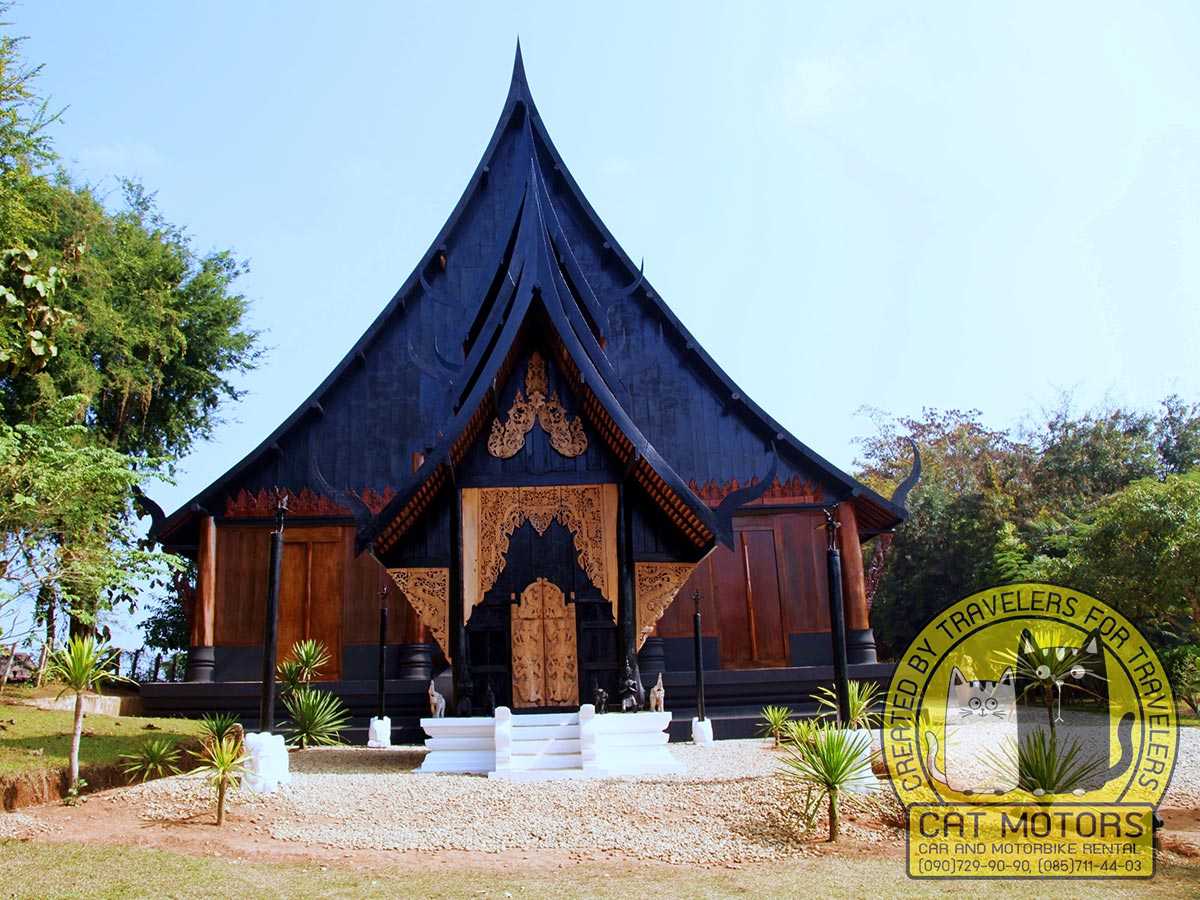
Baan Dam Museum (Google Map) is about 12 km (7.5 miles) north of Chiang Rai city center in the Nang Lae District. It is in a residential area and set on massive grounds of approximately 160 000 m² (over 100 rais). The museum boasts over 40 structures, predominantly constructed from black wood and decorated with animal skins, animal bones, and horns.
The exhibition doesn’t fit the typical image of an art museum. Instead of displaying all shapes and sizes of bright and colorful artworks, it is full of dark, eerie pieces, sculptures, and installations that expose the darker side of life. Often called Northern Thailand’s most disturbing tourist attraction and the counterpart of the White Temple a short distance away, visitors won’t leave the museum unaffected.

Location: 414, Moo 13, Nang Lae, Chiang Rai, 57100
Google Map: Find Routes
Plus Code Map: 7MFXXVR6+R6
Latitude: 19.9920625
Longtitude: 99.8605625
Opening hours: from 9 a.m. to 5 p.m., everyday
Entrance fee: 80 THB
Visitors exempt from entrance fees:
• Children below 12 years old or not taller than 120 centimeters
• Students in uniforms or have verified student IDs
• Government officials in uniforms or have verified IDs
• Tour guides with verified IDs
• Monks or religious figures of all beliefs
• Pregnant women
• Elders; 60-years-olds and older
• Handicapped persons or people with disabilities
Founder: Thawan Duchanee
Year built: 2009
The Origins And Architecture Of Baan Dam Museum
The museum is the realization of Thawan Duchanee’s dream, a dream that grew and took decades to finish. This massive property served as a residence and studio for the late National Artist and architect, Duchanee. He began to develop it as early as 1975, eventually turning it into the impressive yet haunting attraction it is today.
Boasting an eclectic blend of typical Northern Thai architecture and strange contemporary designs. The first building erected in the 70s was the triangular house. In 1992 Duchanee built the Small Temple, characterized by its Lanna-style wood carving, tiered roof, and apex gable. Two years later, in 1994, Duchanee erected the Eastern Pavilion.
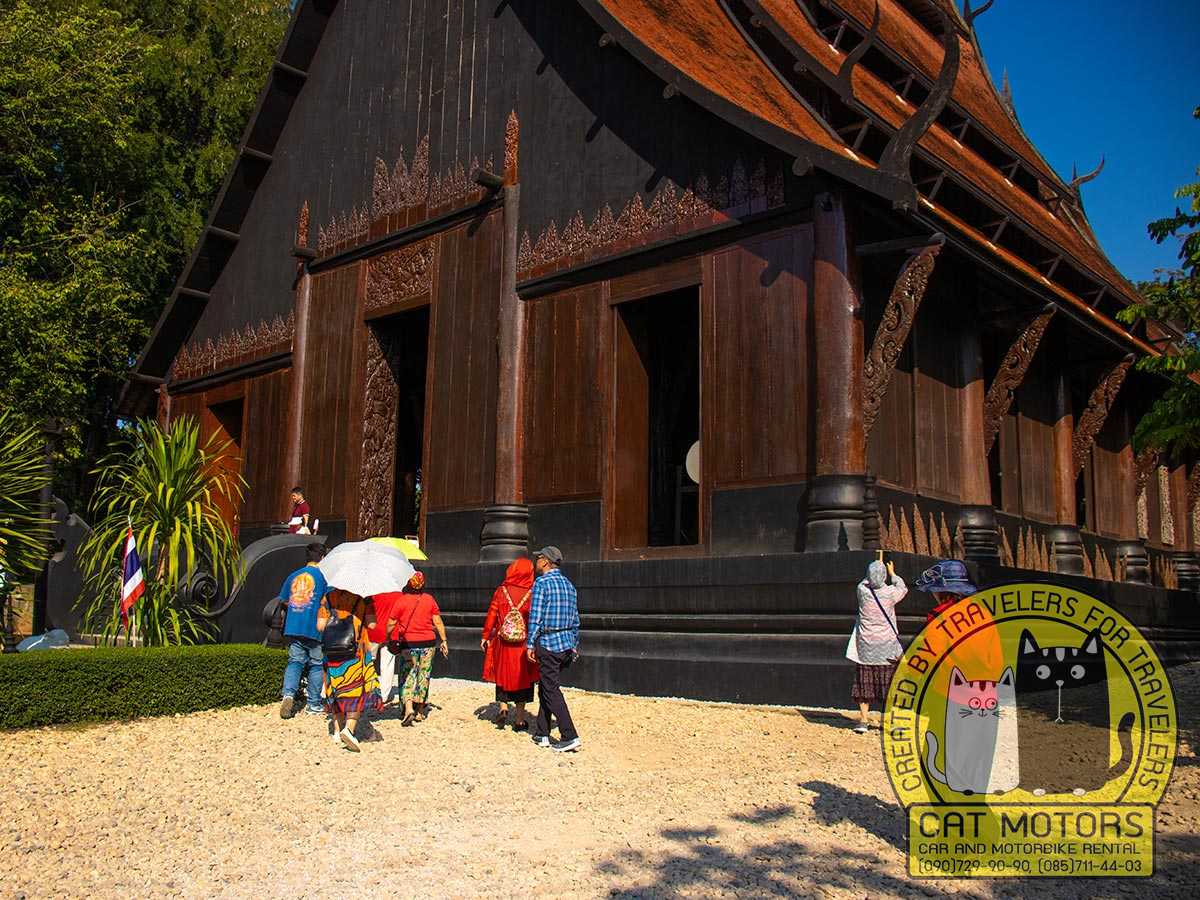
Thawan Duchanee designed the largest building, known as the Cathedral. It’s an enormous wooden structure supported by 44 pillars, with a steeply-pitched, 4-tiered, Lanna-style roof. Baan Dam Museum’s engineers built the Cathedral over seven years, and it was finally ready for the public in 2009.
Many of the structures are built in temple style, made of teakwood and painted black, while others have a more contemporary appearance. Some look like igloos or yurts, and there is a very odd building resembling something similar to a whale or a fish, where Duchanee slept while on the premises.
Artworks And Collections
Aside from traditional Thai décor, the overwhelming medium and inspiration for Duchanee’s art at Baan Dam Museum seem to be animal remains. As you enter the Cathedral, a gargantuan table and benches take center place in the room, which is a work of art on its own. True to form, enormous snake-skin table runners decorate the table. For some strange reason, visitors often pop money into the snake’s mouth.

Another building resembling a Buddhist stupa also has a reptilian table runner – an enormous black crocodile encircled by candles. It’s situated in a circular room with many chairs made from buffalo horns and skins lining the walls.
Several buildings contain paintings, sculptures, animal bones, horns, skins, and skulls, intricately arranged to convey the artist’s somber messages. Although the museum assures visitors that all animals died naturally, it can be upsetting for animal lovers to be surrounded by these remains. Thawan Duchanee depicted suffering, sickness, and old age using the bones and skins of animals in his collections.
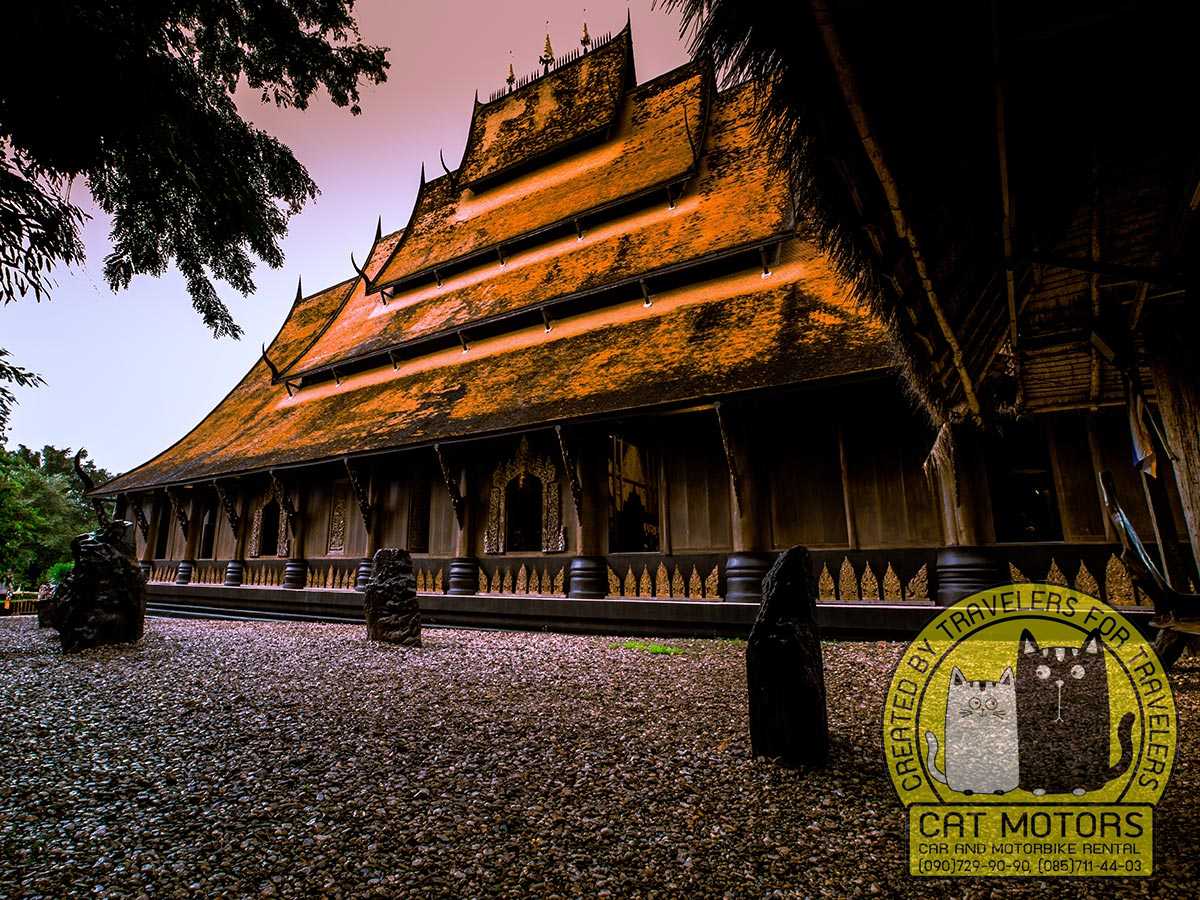
However, not everything at Baan Dam Museum is eerie or morbid. Some magnificent wooden carvings hang from the rafters in the main building, with intricate details that must have taken years to complete. Exquisite tapestries and stunning carved furniture adorn the rooms, which even non-art-savvy visitors can appreciate.
Almost all the huts are painted black, Thawan’s favorite color, hence the name Baan Dam, which means Black House in Thai. Each place is decorated with lovely wooden sculptures and animal horn mounts, such as over 100 pieces of buffalo horns, deer horns, crocodile skin, large sea shells, and animal bones such as elephant bones. As most of the buildings are painted in black, which is a complete contrast to Chalermchai’s Wat Rong Khun, which has a dominantly white color, the locals tend to allude that “Chalerm created heaven while Thawan created hell.”

The areas within Baan Dam are surrounded by many big and small trees and have a calm atmosphere. There are a total of 40 huts, each with its own different characteristics. Only 2-3 huts can be entered, while you can only peek inside through the front doors for others. The collectibles and objects displayed in each hut reflect a different concept. The huts were not created as dwellings but to keep various collectibles of Thawan. However, there are only a few of Thawan’s paintings in Baan Dam.
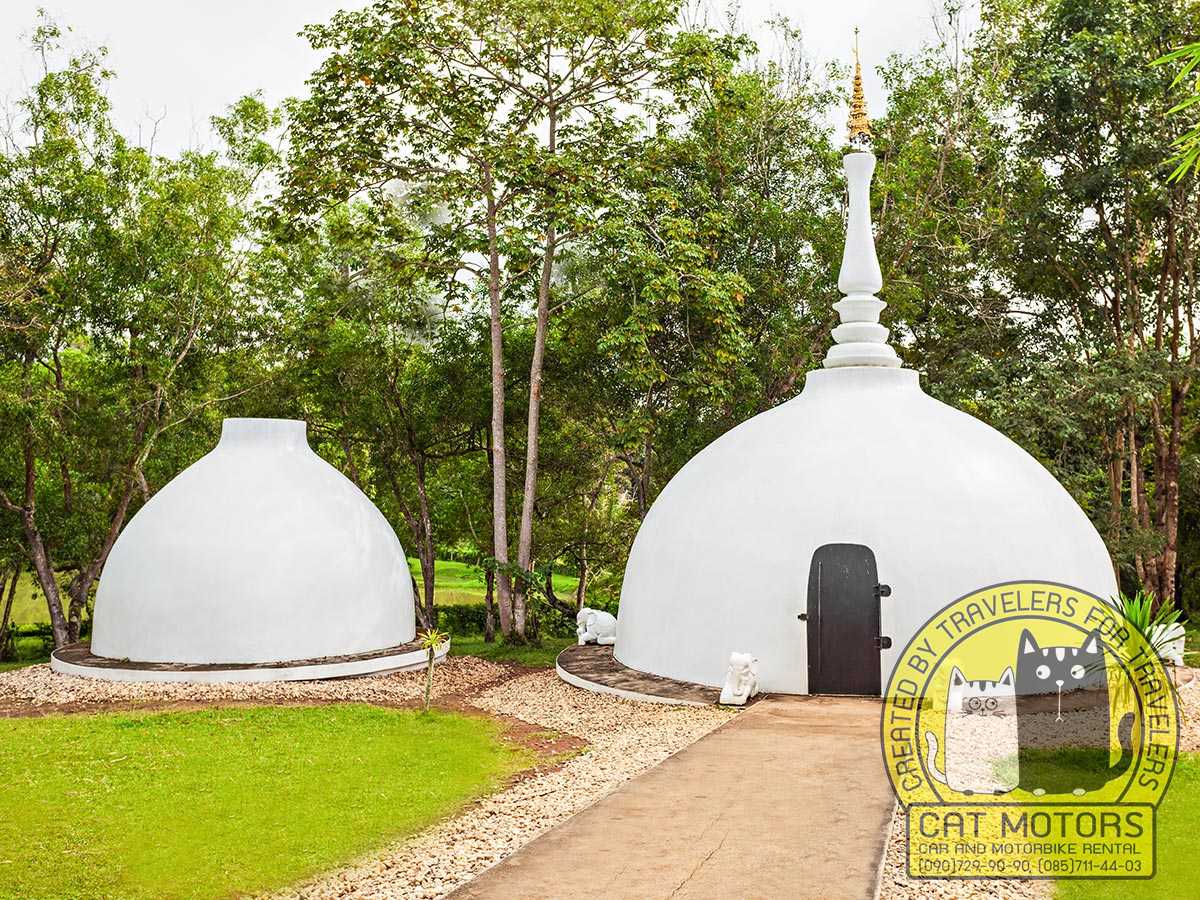
The first point of interest is the small temple in the front, followed by the cathedral, which looks like a large and grand black traditional Thai house. Inside the cathedral is a wide-open hall with various collectibles and works of art from paintings, sculptures, animal mounts, etc. There is also a huge black crocodile skin on a really long table.
If you go traveling to Chiang Rai, don’t forget to visit Singha Park.
Behind the cathedral are several huts, each with its own unique artistic style and shape, from Ruen Lhong Khao, Sala Phra Si Ariyabot, Ruen Sung Sumarn, Baan Dam Ka Lae Keaw Fah, Sala Tawan Ok, Hong Taem, etc. You can tour each house and immerse yourself in Thawan’s works of art.
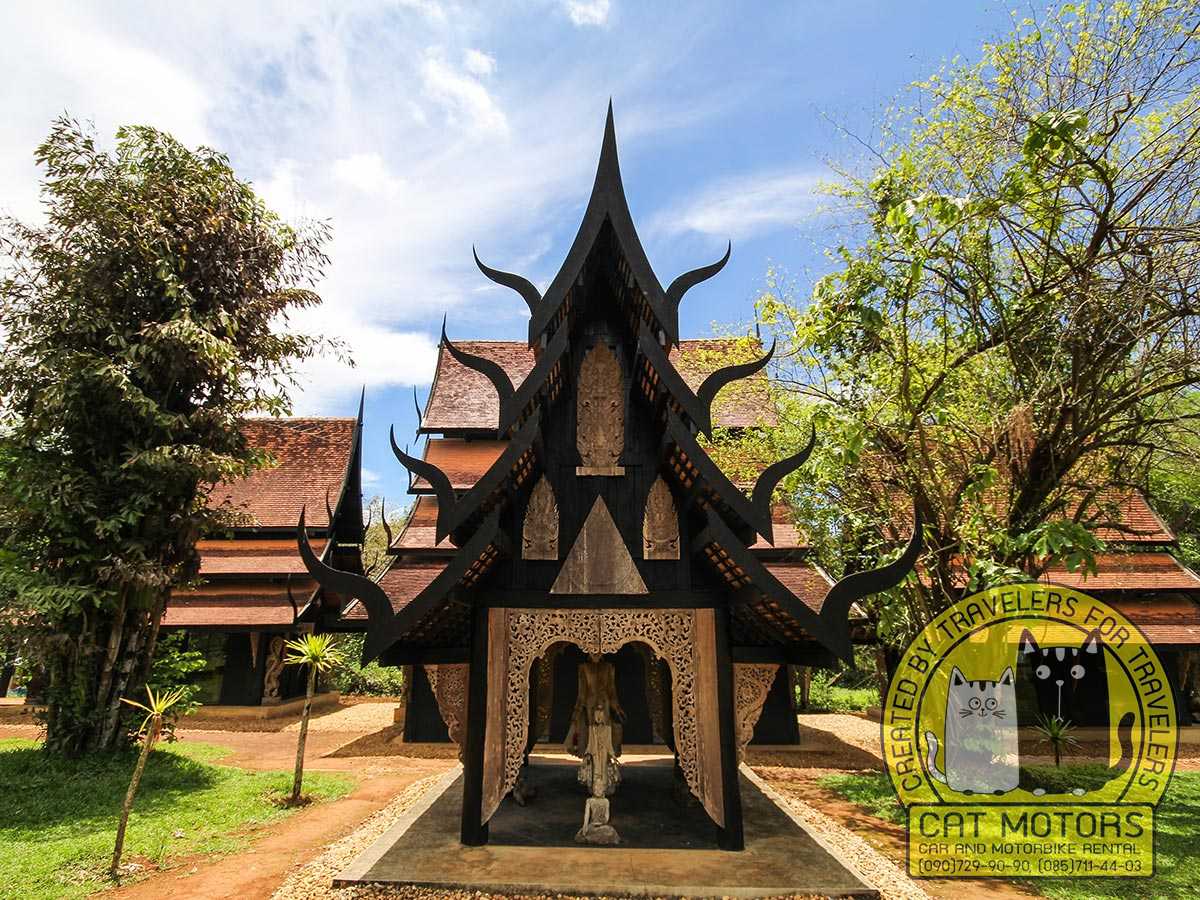
Ruen Lhong Khao can be translated to “Barn Hut”, Sala Phra Si Ariyabot can be roughly translated to “Four Postures of Buddha Pavillion”, Ruen Sung Samarn can be translated to “Crocodile Hut”,
Baan Dam Ka Lae Keaw Fah is a bit tricky. “Ka Lae” is a name for a unique Lanna roof attachment that is believed to be able to ward off crows (“Ka” in Thai) because they brought bad luck. “Keaw Fah” means “Hooked to the Sky”. I suppose it’s to mean that the “Ka Lae” piece of this building is “hooked to the sky”, hence the name. So, the full name could be roughly translated to “A black house with a Ka Lae that’s hooked to the sky”.
Sala Tawan Ok means “East Pavillion”, and Hong Taem is roughly translated to “Marked Room”
Even though Thawan has passed away, Baan Dam continues to open for visitors to experience the unique artistic beauty.

The Symbolism And Themes Of The Museum
Baan Dam Museum is home to more than 4000 artifacts and antiques Duchanee collected over the years. But they are not typical museum material, and there’s a good reason for that. The museum is a representation of the dark and macabre side of life.
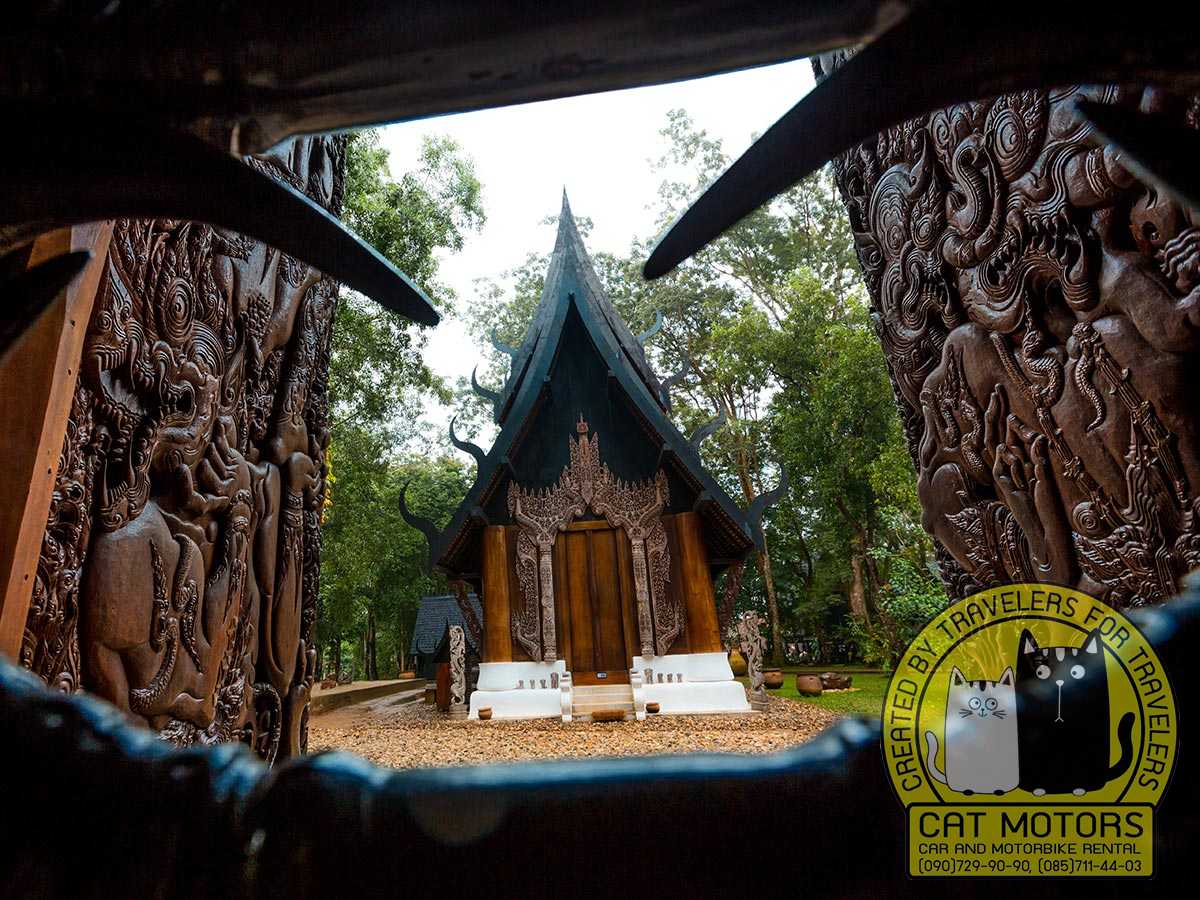
Thawan Duchanee was a devout Buddhist, but instead of devoting his art to the peace-loving side of the religion, the art collections focus on the suffering and hell of Samsara – the circle of life, death, and rebirth.
The collections in each building at Baan Dam Museum focus on different themes relating to mortality and undesirable characteristics of the human race, like greed and lust. Many artworks represent the suffering and pain that the Buddha witnessed on his travels.
Some artwork focuses on sexual desire and cravings, with some very explicit phallic statues and paintings. Although, as adults, we understand that viewing art comes with the understanding that the artist is conveying a message with his piece, these collections may not be suitable for children, so a quick run in the garden may be in order to distract them.
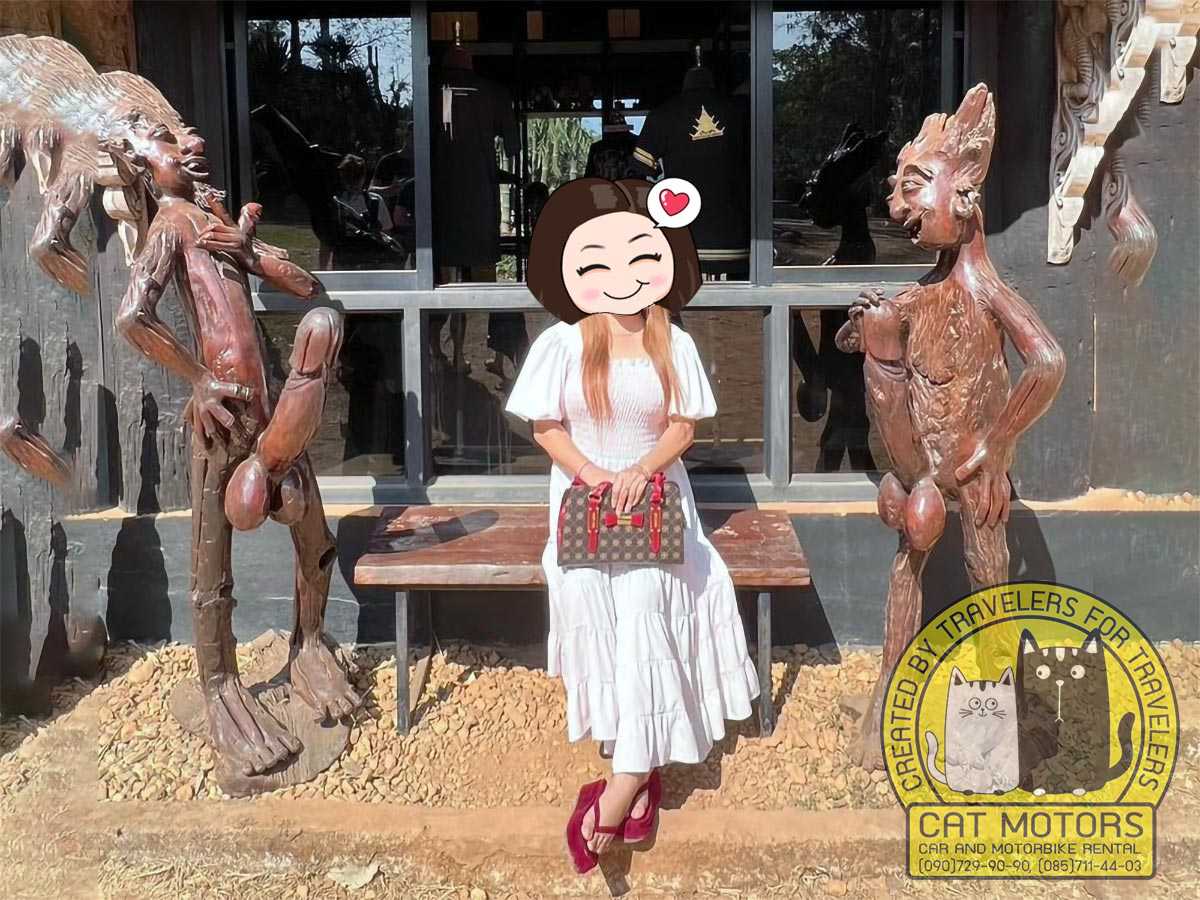
What To Expect When Visiting Baan Dam Museum
From Chiang Rai’s famous clock tower in the city center, you can expect the drive to take 20 – 30 minutes, and you have various options to get there.
Many visitors rent scooters as their mode of transport in Thailand. It’s a cheap and fun way to explore the country. However, if you’re going to hit the highways, as you must when visiting Baan Dam Museum, you should be confident in driving in high-speed traffic.
You will travel north on Route 1 out of Chiang Rai, traveling 10.5 km (6.5 miles), and take a left turn after passing the hospital. As you wind your way down this road, look for signs to the following left turn. As you near Baan Dam Museum, you will see several cafes that have opened to benefit from the increased tourism the Black House has drawn in recent years.
If you see yourself as potential roadkill when hiring a scooter or motorcycle, it’s best to use public transportation. Learning to ride a scooter on Thai highways is probably a recipe for disaster.
One of the cheapest modes of transport is the public bus, which you will locate at the old bus terminal in Chiang Rai’s city center. Alternatively, you can hail any northbound songthaew or hire a taxi. If you tell the drivers “bai (go) Baan Dam,” they will know where you want to go. However, don’t ask for the Black House, as most Thai people don’t recognize that name.
Tips For Visiting The Black House
- Open daily from 9 am to 5 pm but closes for lunch between 12 pm and 1 pm.
- All adults, Thai or foreigners, pay an entrance fee of 80 baht. Children under 12 don’t pay an admission fee, and people with disabilities are also free.
- Baan Dam Museum has become a popular tourist destination, so if you’re averse to crowds, visit at opening time or late afternoon to avoid the rush.
- There are no English signposts or explanations of the art on display, so you will have to let your imagination loose when interpreting the art.
- The Baan Dam buildings are scattered around the grounds, almost in a maze layout. As you wander between the structures and sculptures, wear sunscreen or take a hat. If your visit falls in the wet season, carry an umbrella.
- Although Baan Dam Museum boasts around 40 buildings and structures, not all are available for viewing by the public. You can view some through doorways and windows, but others are off-limits. The Thai Royal Family has used some of these buildings for meditation, which remain unavailable for viewing.
- There is sufficient parking at the main entrance.
- Restrooms are available, very clearly marked with the genitals of the respective genders!
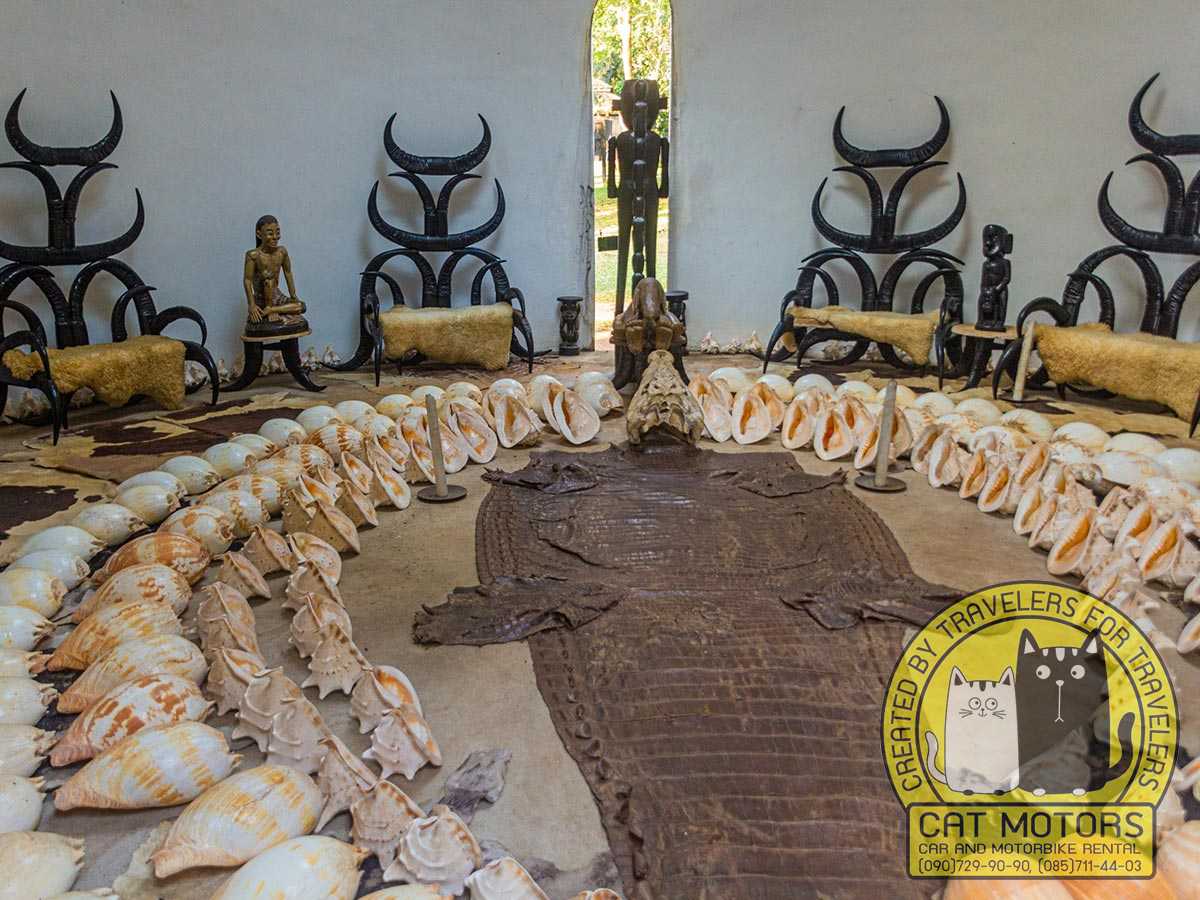
What To Do After Leaving The Black House
As marvelous and fascinating as Baan Dam Museum is, a couple of hours of the macabre is enough for most people. Before you head for new adventures, you might need some tea or coffee to bolster your mood and energy.
Fortunately, the Nanglae Coffee House is right next door to the museum, ready and willing to serve you. The coffee is locally produced and grown in Chiang Mai Province, and the restaurant roasts the beans on-site. Coffee, matcha tea, and iced chocolate have an excellent reputation at Nanglae Coffee House. The café serves Thai and international cuisine and also bakes cakes on the premises.
If you want to purchase some gifts or souvenirs, there is also a souvenir shop on the Baan Dam Museum premises where you can buy art replicas and handicrafts.
Nearby Attractions
Now you’re ready to leave for greener (or at least more colorful) pastures, let us paint some prettier pictures of popular attractions close to Baan Dam Museum.
Visit The Glistening Wat Rong Khun
Less than 30 km (18 miles) from the museum lies the White Temple, Wat Rong Khun, a must-see destination in Chiang Rai. Although it is a stark contrast to the dark color and aura of the Baan Dam Museum, it is no less eccentric.
When you think of a temple, religion, and peacefulness come to mind, but the artist, Chalermchai Kositpipat, added some unconventional ideas to this glistening white structure. Although much of the temple depicts the themes of Theravada Buddhism, you will also find images of Harry Potter, Hello Kitty, and Michael Jackson, to name a few.
Visitors must cross the Bridge of the Cycle of Rebirth to reach the Gate of Heaven. Underneath the bridge, hundreds of damned souls reach out their hands to represent worldly cravings such as alcohol, smoking, lust, and greed, which we must resist to enter heaven.
From Baan Dam Museum, you can expect a drive time of around 20-30 minutes traveling south on Route 131. Transport options include renting a scooter, or a private car, hailing a taxi, songthaew, or tuk-tuk, or taking a local bus, which would probably be the cheapest. Entrance into Wat Rong Khun is 50 baht for foreigners, or “farang.” Remember to dress conservatively as it is a religious site.
Family Fun At Singha Park
A relaxing family outing after visiting Baan Dam Museum should include a trip to Singha Park. It’s approximately 24.9 km (15.4 miles) south of the Black House on Route 131, the same road that would take you to Wat Rong Khun. Entrance to Singha Park is free, but you will have to pay for any activities.
Singha Park is a combination of a park and a farm, consisting of vineyards, orchards, tea plantations, a petting zoo, and activities such as rock climbing, ziplining, and much more. The views are incredible, and there are activities to keep everyone entertained for hours. The farm also boasts a restaurant where you can refuel.
Enjoy A Cuppa At Choui Fong Tea Plantation
Choui Fong Tea plantation lies approximately 31.2 km (19.4 miles) from Baan Dam Museum. However, you will take Route 1 and travel north for about 37 minutes to reach your destination.
The tea plantation is a family-owned concern and the biggest producer of tea in Chiang Rai province, growing Assam, Oolong, Green, and Black tea. There’s a tea shop serving drinks and desserts and a gift shop selling the plantation’s teas and tea products. The tea shop is at the top of the hill and makes for stunning photographs of the plantation. Entrance to the plantation is free.
Relax At Kamlar Herbal Steam
If you prefer a relaxing day after visiting Baan Dam Museum without running from one tourist attraction to another, a visit to Kamlar Herbal Steam would be just the thing, with its Thai massages, steam treatments, and many other wellness center offerings. And it is within walking distance, only 320 m (0.2 miles).
Our Summary
Chiang Rai’s Baan Dam Museum is an eccentric and somewhat eerie gallery exhibiting the works of National Artist and architect Thawan Duchanee. Much of his work includes animal skins, bones, and skulls to depict the darker side of human nature and the suffering we endure because of it.
Visiting the exhibition is a thought-provoking and challenging experience. Even as the dark artworks make us uncomfortable, it challenges us to rise above the darkness of our souls and be better human beings. The museum is a destination that should not be missed.
Weather Forecast
Also check out the other interesting attractions in northern Thailand that we have detailed in our Places to Visit in Chiang Mai travel guide.
FAQ
The Baan Dam Museum, also known as the Black House or Black Temple, was created by Thai artist Thawan Duchanee. The museum is a complex of 40 buildings, exhibiting his artworks. The inspiration behind the museum is Duchanee’s unique interpretation of Buddhism focusing on the darker aspects of human life and nature.
The black color throughout the Black Temple signifies suffering and death in accordance with the artist’s interpretation of Buddhism and life.
Thawan Duchanee is a renowned Thai artist who was selected as National Artist in 2001. His work, influenced by northern Thai culture and Buddhist teachings, pushed boundaries and often sparked controversy, bringing international attention to Thai art.
The best time to visit the Black Temple is in the early morning or late afternoon, when the crowds tend to be smaller.
The museum consists of a complex of around 40 traditional Thai houses made of wood and glass, decorated with motifs in black and gold, and filled with unique and interesting art pieces.
While there are no official guided tours within the complex, English-speaking guides can often be hired at the entrance to provide a deeper understanding of the art and symbolism in the Black Temple.
The museum incorporates traditional Thai building techniques and materials, including wood and glass. Its interior is decorated with a mix of modern and traditional artworks, including intricate wood carvings and sculptures.
Yes, photography is typically allowed inside the Black Temple, but it’s always important to check for any specific restrictions or signs.
Depending on personal interest, a typical visit to the museum could last anywhere from 1 to 2 hours.
Yes, other nearby attractions include the famous White Temple (Wat Rong Khun), the Blue Temple (Wat Rong Suea Ten), and the Golden Triangle where the borders of Thailand, Laos, and Myanmar meet.
Like many cultural and religious sites in Thailand, it’s important to dress respectfully. This typically means no revealing clothes, with shoulders and knees covered.
While the Black Temple is mainly a static exhibit of Thawan Duchanee’s work, occasionally special exhibitions or cultural events might be held. It’s best to check the official website (upd: for unknown reasons, the website is no longer available) or contact the museum directly by number 053 776 333 for the most up-to-date information.
Embark on an exciting journey through Northern Thailand with our comprehensive travel guides. They highlight the most scenic routes and local attractions. Start by exploring our motorbike rental in Chiang Mai homepage, and be sure to review our terms and conditions for a smooth experience. With these resources, you can confidently explore mountain trails and charming villages.
Our travel advice sections offer essential tips on staying safe and enjoying your trip to the fullest. Discover the best times to visit major attractions, learn about local festivals, and find out how to handle different road conditions. These insights will make your journey richer and more enjoyable. Join us in exploring the breathtaking landscapes and vibrant culture of Northern Thailand, ensuring a safe and memorable adventure.
Was this post useful for you?
You can rate it by clicking on a star
Average rating / 5. Vote count:
No votes so far! Be the first to rate this post.
We are sorry that this post was not useful for you!
Let us improve this post!
Tell us how we can improve this post?
- Author: Natcha Lindberg
- Updated: March 26, 2025
- No Comments




